AgilePLM系统简介.pptx
- 格式:pptx
- 大小:4.07 MB
- 文档页数:2

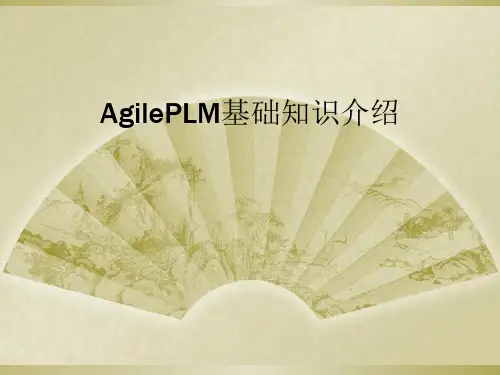

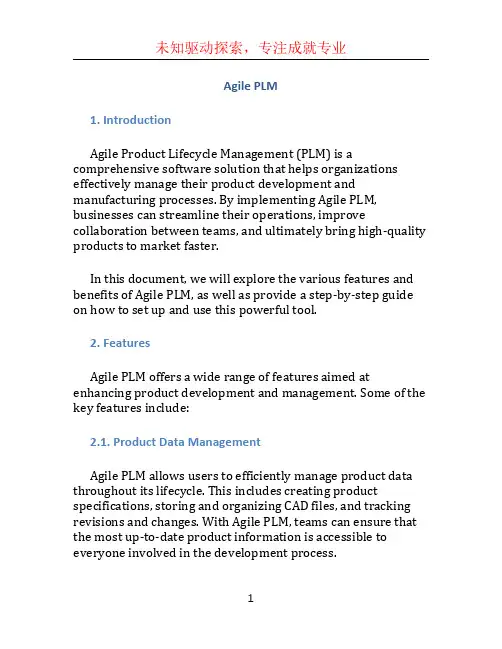
Agile PLM1. IntroductionAgile Product Lifecycle Management (PLM) is a comprehensive software solution that helps organizations effectively manage their product development and manufacturing processes. By implementing Agile PLM, businesses can streamline their operations, improve collaboration between teams, and ultimately bring high-quality products to market faster.In this document, we will explore the various features and benefits of Agile PLM, as well as provide a step-by-step guide on how to set up and use this powerful tool.2. FeaturesAgile PLM offers a wide range of features aimed at enhancing product development and management. Some of the key features include:2.1. Product Data ManagementAgile PLM allows users to efficiently manage product data throughout its lifecycle. This includes creating product specifications, storing and organizing CAD files, and tracking revisions and changes. With Agile PLM, teams can ensure that the most up-to-date product information is accessible to everyone involved in the development process.2.2. Collaboration ToolsOne of the core benefits of Agile PLM is its ability to facilitate collaboration between teams. Users can easily share product information, assign tasks, and track progress. This promotes better communication and ensures that everyone is on the same page throughout the product development lifecycle.2.3. Change ManagementAgile PLM provides robust change management capabilities, enabling organizations to effectively handle product changes and updates. Users can create change orders, track their status, and manage associated workflows. This helps streamline the change management process and ensures that all necessary approvals are obtained before implementing any modifications.2.4. Quality ManagementQuality is paramount in product development, and Agile PLM offers features to support effective quality management. Users can create quality controls, define inspection criteria, and track non-conformances. These features help organizations maintain high-quality standards and make data-driven decisions to continuously improve product quality.3. BenefitsImplementing Agile PLM can bring numerous benefits to organizations. Some of the key advantages include:3.1. Improved Collaboration and CommunicationBy centralizing product data and providing collaboration tools, Agile PLM enhances communication and collaboration between teams. This leads to improved efficiency and faster decision-making, as well as reduced errors and miscommunication.3.2. Accelerated Time-to-MarketWith Agile PLM, organizations can streamline their product development processes, reducing time wasted on manual tasks and administrative overhead. This results in faster product introductions and increased competitiveness in the market.3.3. Enhanced Product QualityThe quality management features of Agile PLM help organizations maintain high-quality standards and address any issues promptly. By capturing and analyzing quality data, organizations can identify trends and make data-driven improvements to their products.3.4. Regulatory ComplianceAgile PLM allows organizations to ensure compliance with regulatory requirements and industry standards. By providing a structured approach to managing product data and change requests, organizations can demonstrate adherence to regulations and minimize compliance risks.4. Implementation guideTo set up and use Agile PLM effectively in your organization, follow the steps below:4.1. Define Objectives and RequirementsStart by clearly defining your organization’s objectives and requirements for implementing Agile PLM. This includes understanding the specific challenges you want to address and the goals you want to achieve with the tool.4.2. Plan and Design the SolutionBased on your objectives, design a solution architecture that aligns with your organization’s internal processes and workflows. Identify the necessary modules and features of Agile PLM that will best support your requirements.4.3. Configure and CustomizeConfigure Agile PLM to match y our organization’s specific needs. This includes setting up user roles and permissions, customizing data fields and workflows, and integrating Agile PLM with other software tools used in your organization.4.4. Populate DataMigrate existing product data into Agile PLM and ensure its accuracy and completeness. This may involve importing data from spreadsheets or other legacy systems, and performing data cleansing and validation.4.5. Train UsersProvide comprehensive training to all users on how to effectively use Agile PLM. This includes explaining the various features and functionalities, demonstrating best practices, and addressing any user questions or concerns.4.6. Test and ValidateThoroughly test the configured Agile PLM solution to ensure it functio ns as intended and meets your organization’s requirements. Validate data accuracy and perform end-to-end testing of critical workflows and processes.4.7. Go Live and Continuously ImproveOnce testing is complete, launch Agile PLM in your production environment. Monitor its performance, gather user feedback, and continuously improve the system based on user and business needs.ConclusionAgile PLM is a powerful tool that can revolutionize product development and management within organizations. By implementing Agile PLM, businesses can streamline their operations, improve collaboration, and bring higher-quality products to market faster. Follow the implementation guide provided in this document to successfully set up and leverage the capabilities of Agile PLM in your organization.。
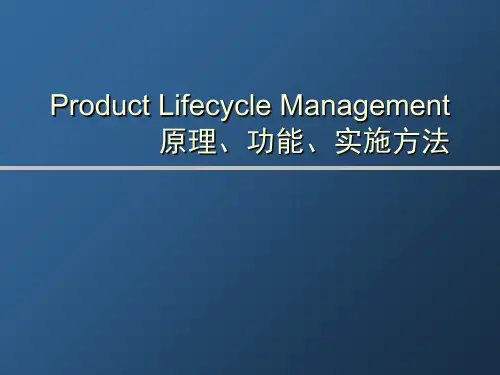
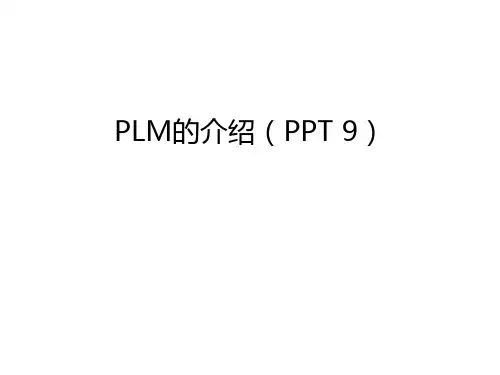
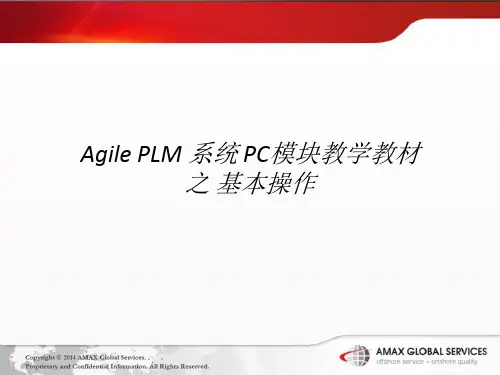
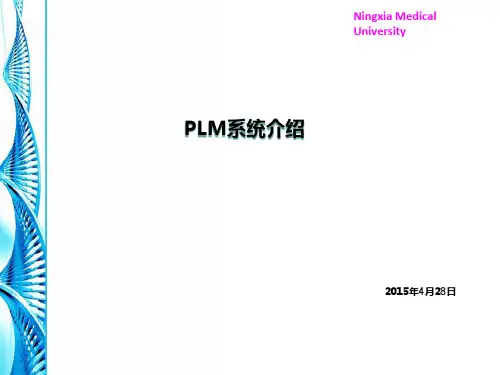
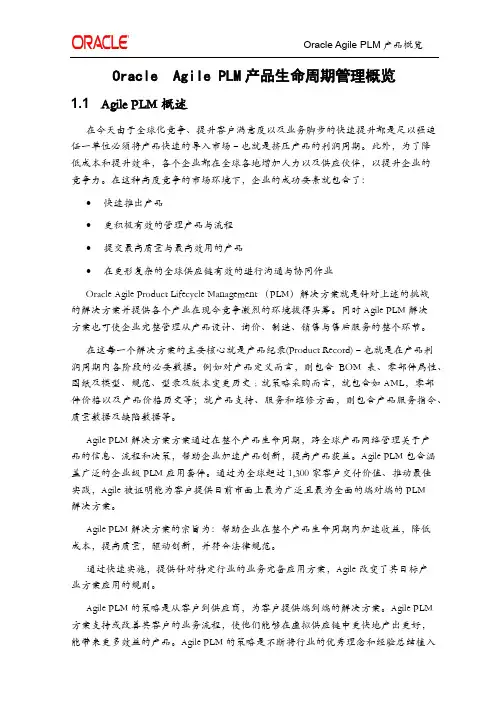
Oracle Agile PLM产品生命周期管理概览1.1 Agile PLM概述在今天由于全球化竞争、提升客户满意度以及业务脚步的快速提升都是足以强迫任一单位必须将产品快速的导入市场–也就是挤压产品的利润周期。
此外,为了降低成本和提升效率,各个企业都在全球各地增加人力以及供应伙伴,以提升企业的竞争力。
在这种高度竞争的市场环境下,企业的成功要素就包含了:∙快速推出产品∙更积极有效的管理产品与流程∙提交最高质量与最高效用的产品∙在更形复杂的全球供应链有效的进行沟通与协同作业Oracle Agile Product Lifecycle Management (PLM)解决方案就是针对上述的挑战的解决方案并提供各个产业在现今竞争激烈的环境拔得头筹。
同时Agile PLM解决方案也可使企业完整管理从产品设计、询价、制造、销售与售后服务的整个环节。
在这每一个解决方案的主要核心就是产品纪录(Product Record)–也就是在产品利润周期内各阶段的必要数据。
例如对产品定义而言,则包含BOM表、零部件属性、图纸及模型、规范、型录及版本变更历史﹔就策略采购而言,就包含如AML,零部件价格以及产品价格历史等;就产品支持、服务和维修方面,则包含产品服务指令、质量数据及缺陷数据等。
Agile PLM解决方案方案通过在整个产品生命周期,跨全球产品网络管理关于产品的信息、流程和决策,帮助企业加速产品创新,提高产品获益。
Agile PLM包含涵盖广泛的企业级PLM应用套件。
通过为全球超过1,300家客户交付价值、推动最佳实践,Agile被证明能为客户提供目前市面上最为广泛且最为全面的端对端的PLM解决方案。
Agile PLM解决方案的宗旨为:帮助企业在整个产品生命周期内加速收益,降低成本,提高质量,驱动创新,并符合法律规范。
通过快速实施,提供针对特定行业的业务完备应用方案,Agile改变了其目标产业方案应用的规则。
Agile PLM的策略是从客户到供应商,为客户提供端到端的解决方案。
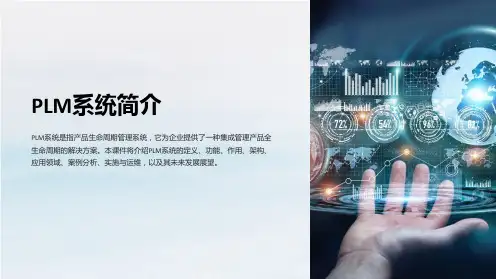
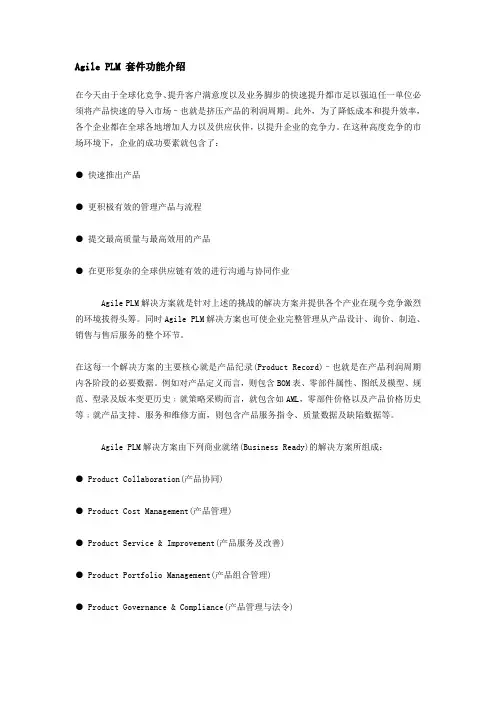
Agile PLM 套件功能介绍在今天由于全球化竞争、提升客户满意度以及业务脚步的快速提升都市足以强迫任一单位必须将产品快速的导入市场–也就是挤压产品的利润周期。
此外,为了降低成本和提升效率,各个企业都在全球各地增加人力以及供应伙伴,以提升企业的竞争力。
在这种高度竞争的市场环境下,企业的成功要素就包含了:● 快速推出产品● 更积极有效的管理产品与流程● 提交最高质量与最高效用的产品● 在更形复杂的全球供应链有效的进行沟通与协同作业Agile PLM解决方案就是针对上述的挑战的解决方案并提供各个产业在现今竞争激烈的环境拔得头筹。
同时Agile PLM解决方案也可使企业完整管理从产品设计、询价、制造、销售与售后服务的整个环节。
在这每一个解决方案的主要核心就是产品纪录(Product Record)–也就是在产品利润周期内各阶段的必要数据。
例如对产品定义而言,则包含BOM表、零部件属性、图纸及模型、规范、型录及版本变更历史﹔就策略采购而言,就包含如AML,零部件价格以及产品价格历史等﹔就产品支持、服务和维修方面,则包含产品服务指令、质量数据及缺陷数据等。
Agile PLM解决方案由下列商业就绪(Business Ready)的解决方案所组成:● Product Collaboration(产品协同)● Product Cost Management(产品管理)● Product Service & Improvement(产品服务及改善)● Product Portfolio Management(产品组合管理)● Product Governance & Compliance(产品管理与法令)● Engineering Collaboration(工程协同)每一个解决方案都提供企业体在供应炼各方面的高度透明度,强化客户与供货商降低成本、提升效率并更快制造出更好、更具利润产品的能力。
所有Agile解决方案都是构筑在Agile PLM Platform上。
Agile PLMIntroductionAgile Product Lifecycle Management (PLM) is a software solution designed to help organizations manage their product development and lifecycle processes in a more efficient and agile manner. It provides a centralized platform for teams to collaborate, automate workflows, and track product information from conception to retirement.Key Features1. Product data managementAgile PLM offers robust product data management capabilities, allowing organizations to manage and control product information across the entire lifecycle. It provides a centralized repository for storing and organizing product specifications, BOMs (Bill of Materials), drawings, and other related documents. This ensures that stakeholders have access to accurate and up-to-date information, promoting collaboration and reducing errors.2. Agile project managementWith Agile PLM, organizations can manage their product development projects using agile methodologies. It supports features such as backlog management, user story tracking, sprint planning, and task management. This helps teams toplan, track, and prioritize their work effectively, resulting in improved productivity and faster time-to-market.3. Collaboration and workflow automationAgile PLM enables teams to collaborate seamlessly across different functions and departments. It provides features such as document sharing, real-time commenting, and version control, facilitating effective communication and collaboration. Additionally, it allows organizations to automate their workflows, ensuring that tasks and approvals are routed to the right stakeholders at the appropriate stages of the product lifecycle.4. Change managementManaging changes effectively is critical to product development success. Agile PLM includes change management capabilities that enable organizations to track and manage product changes efficiently. It provides a standardized process for change requests, impact analysis, and change implementation. This helps organizations to evaluate the impact of changes on the entire product lifecycle and make informed decisions.5. Quality managementEnsuring product quality is essential for customer satisfaction and regulatory compliance. Agile PLM offers quality management features to help organizations streamline their quality control processes. It provides tools for managing quality requirements, conducting inspections and audits, tracking non-conformances, and facilitating corrective andpreventive actions. This helps organizations to identify and address quality issues early on, minimizing risks and ensuring product conformity.BenefitsImplementing Agile PLM brings several benefits to organizations:1.Improved collaboration and communication acrossteams2.Increased visibility and transparency into productdevelopment processes3.Quicker time-to-market through agile projectmanagement approaches4.Enhanced control and traceability of product dataand changes5.Streamlined workflows and increased operationalefficiency6.Better compliance with regulatory requirementsand quality standardsConclusionAgile PLM is a powerful software solution that helps organizations manage their product development and lifecycle processes in a more efficient and agile manner. By providingcentralized control, collaboration, and automation capabilities, it enables organizations to streamline their workflows, improve communication, and accelerate time-to-market. Implementing Agile PLM can bring substantial benefits, including increased productivity, improved quality control, and stronger customer satisfaction.。
Agile PLM1. Introduction to Agile PLMAgile Product Lifecycle Management (PLM) is a comprehensive software solution that helps organizations manage their product development processes, from ideation to commercialization. It enables companies to streamline their product development, reduce time-to-market, and improve collaboration between various stakeholders. Agile PLM provides a platform that integrates product data, processes, and people, supporting the entire product lifecycle.2. Key Features of Agile PLMAgile PLM offers a wide range of features and functionalities that facilitate efficient product development. Some of the key features include:2.1 Product Data Management (PDM)Agile PLM provides robust product data management capabilities, allowing organizations to centralize and manage all product-related data. It enables teams to store and organize data such as bills of materials (BOMs), CAD files, specifications, and documents. The PDM functionality ensures that all stakeholders have access to the most up-to-date and accurate product information.Change management is a critical aspect of product development, and Agile PLM offers extensive change management capabilities. It enables teams to track and manage changes throughout the product development process, ensuring that all changes are documented, reviewed, and implemented effectively. Change management in Agile PLM includes features such as change orders, approval workflows, and audit trails.2.3 Project ManagementAgile PLM provides project management features that help organizations plan, track, and execute product development projects efficiently. It allows teams to define project timelines, allocate resources, track milestones, and monitor project progress. The project management functionality in Agile PLM facilitates collaboration and coordination among team members, ensuring that projects are completed on time and within budget.2.4 Supplier CollaborationAgile PLM enables organizations to collaborate effectively with suppliers throughout the product development process. It provides tools and functionalities that allow for easy communication, document sharing, and collaboration with suppliers. This helps streamline the supplier evaluation, selection, and qualification processes, ensuring efficient supply chain management.Quality management is crucial in ensuring that products meet customer expectations and comply with industry standards. Agile PLM offers quality management features that enable organizations to define and enforce quality control processes. It provides tools for tracking product quality issues, implementing corrective actions, and monitoring product quality metrics.3. Benefits of Agile PLMThe adoption of Agile PLM can bring several benefits to organizations, including:3.1 Improved Efficiency and ProductivityAgile PLM enables organizations to streamline their product development processes, eliminating manual and inefficient processes. It helps reduce errors, rework, and duplication of efforts, thereby improving overall efficiency and productivity. With Agile PLM, teams can collaborate more effectively, share information seamlessly, and make informed decisions based on accurate and up-to-date data.3.2 Faster Time-to-MarketAgile PLM helps organizations accelerate time-to-market by providing a structured and streamlined product development process. It enables teams to manage product data effectively, automate workflows, and track changes efficiently. This results in faster product development cycles, enabling organizationsto bring new products to market more quickly and gain a competitive edge.3.3 Enhanced CollaborationCollaboration is a key driver of successful product development, and Agile PLM facilitates collaboration among various stakeholders. It provides a centralized platform where teams can collaborate, share information, and communicate effectively. This improves cross-functional coordination and ensures that everyone is working towards the same goal, ultimately leading to better product outcomes.3.4 Improved Visibility and ControlAgile PLM provides organizations with better visibility into their product development processes and greater control over product data. It allows teams to track and monitor project progress, identify bottlenecks, and take proactive measures to address issues. This enhanced visibility and control enable organizations to make data-driven decisions, mitigate risks, and optimize resource allocation.4. ConclusionAgile PLM is a comprehensive software solution that empowers organizations to effectively manage their product development processes. It offers a range of features and functionalities that enhance efficiency, collaboration, and control throughout the product lifecycle. By leveraging Agile PLM, organizations can reduce time-to-market, improve product quality, and gain a competitive edge in today’s fast-paced and dynamic market environment.。